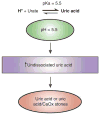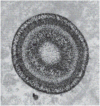Recent advances in the pathophysiology of nephrolithiasis
- PMID: 19078968
- PMCID: PMC3088505
- DOI: 10.1038/ki.2008.626
Recent advances in the pathophysiology of nephrolithiasis
Abstract
Over the past 10 years, major progress has been made in the pathogenesis of uric acid and calcium stones. These advances have led to our further understanding of a pathogenetic link between uric acid nephrolithiasis and the metabolic syndrome, the role of Oxalobacter formigenes in calcium oxalate stone formation, oxalate transport in Slc26a6-null mice, the potential pathogenetic role of Randall's plaque as a precursor for calcium oxalate nephrolithiasis, and the role of renal tubular crystal retention. With these advances, we may target the development of novel drugs including (1) insulin sensitizers; (2) probiotic therapy with O. formigenes, recombinant enzymes, or engineered bacteria; (3) treatments that involve the upregulation of intestinal luminal oxalate secretion by increasing anion transporter activity (Slc26a6), luminally active nonabsorbed agents, or oxalate binders; and (4) drugs that prevent the formation of Randall's plaque and/or renal tubular crystal adhesions.
Conflict of interest statement
The author declared no competing interest.
Figures







Comment in
-
The missing medullary sponge kidney.Kidney Int. 2009 Aug;76(4):459-60; author reply 460. doi: 10.1038/ki.2009.163. Kidney Int. 2009. PMID: 19644481 No abstract available.
Similar articles
-
The role of the microbiome in kidney stone formation.Int J Surg. 2016 Dec;36(Pt D):607-612. doi: 10.1016/j.ijsu.2016.11.024. Epub 2016 Nov 12. Int J Surg. 2016. PMID: 27847292 Free PMC article. Review.
-
Contribution of Dietary Oxalate and Oxalate Precursors to Urinary Oxalate Excretion.Nutrients. 2020 Dec 28;13(1):62. doi: 10.3390/nu13010062. Nutrients. 2020. PMID: 33379176 Free PMC article. Review.
-
The genetic composition of Oxalobacter formigenes and its relationship to colonization and calcium oxalate stone disease.Urolithiasis. 2013 Jun;41(3):187-96. doi: 10.1007/s00240-013-0566-7. Epub 2013 Apr 30. Urolithiasis. 2013. PMID: 23632911 Free PMC article. Review.
-
Role of gut microbiota against calcium oxalate.Microb Pathog. 2017 Aug;109:287-291. doi: 10.1016/j.micpath.2017.06.009. Epub 2017 Jun 15. Microb Pathog. 2017. PMID: 28624518 Review.
-
Sel1-like proteins and peptides are the major Oxalobacter formigenes-derived factors stimulating oxalate transport by human intestinal epithelial cells.Am J Physiol Cell Physiol. 2023 Jul 1;325(1):C344-C361. doi: 10.1152/ajpcell.00466.2021. Epub 2023 May 1. Am J Physiol Cell Physiol. 2023. PMID: 37125773 Free PMC article.
Cited by
-
Simultaneous expression of ClopHensor and SLC26A3 reveals the nature of endogenous oxalate transport in CHO cells.Biol Open. 2019 Apr 1;8(4):bio041665. doi: 10.1242/bio.041665. Biol Open. 2019. PMID: 30837228 Free PMC article.
-
The multiple roles of pendrin in the kidney.Nephrol Dial Transplant. 2015 Aug;30(8):1257-66. doi: 10.1093/ndt/gfu307. Epub 2014 Oct 3. Nephrol Dial Transplant. 2015. PMID: 25281699 Free PMC article. Review.
-
Metabolic Syndrome and Nephrolithiasis Risk: Should the Medical Management of Nephrolithiasis Include the Treatment of Metabolic Syndrome?Rev Urol. 2015;17(3):117-28. Rev Urol. 2015. PMID: 26543426 Free PMC article.
-
Treatment of patients with uric acid stones.Urolithiasis. 2016 Feb;44(1):57-63. doi: 10.1007/s00240-015-0843-8. Epub 2015 Dec 8. Urolithiasis. 2016. PMID: 26645868 Review.
-
Association Between Dietary Selenium Intake and Kidney Stones Disease Among Patients with Metabolic Syndrome: A Cross-Sectional Study from the NHANES Database.J Multidiscip Healthc. 2024 Dec 31;17:6255-6264. doi: 10.2147/JMDH.S496819. eCollection 2024. J Multidiscip Healthc. 2024. PMID: 39759084 Free PMC article.
References
-
- Asplin JR. Hyperoxaluric calcium nephrolithiasis. Endocrinol Metab Clin North Am. 2002;31:927–949. - PubMed
-
- Uribarri J, Oh MS, Carroll HJ. The first kidney stone. Ann Intern Med. 1989;111:1006–1009. - PubMed
-
- Johnson CM, Wilson DM, O’Fallon WM, et al. Renal stone epidemiology: a 25-year study in Rochester, Minnesota. Kidney Int. 1979;16:624–631. - PubMed
-
- Stamatelou KK, Francis ME, Jones CA, et al. Time trends in reported prevalence of kidney stones in the United States: 1976–1994. Kidney Int. 2003;63:1817–1823. - PubMed
-
- Worcester E, Parks JH, Josephson MA, et al. Causes and consequences of kidney loss in patients with nephrolithiasis. Kidney Int. 2003;64:2204–2213. - PubMed
Publication types
MeSH terms
Substances
Grants and funding
LinkOut - more resources
Full Text Sources
Other Literature Sources
Medical
Miscellaneous

